Primula, Fairy Primrose - Primula malacoides
 Primula malacoides 'White'Condensed Version:
Primula malacoides 'White'Condensed Version:
Primulas provide relief from a somewhat barren winter landscape, and no winter and spring garden is complete without them.
Primulas require cool conditions and high humidity to produce high quality plants, and in hotter climates like South Africa we grow them as winter and spring flowering annuals for semi-shade. Fairy primulas grow well almost throughout the country and are hardy to frost and low temperatures, but do not like heat together with high humidity. They do very well in the winter rainfall regions, and in the summer rainfall regions they must be watered regularly.
Trays of seedlings are available from April, and in South Africa it is best to plant these no later than mid-May. Select sites which are protected from strong winds; and plant in well-prepared beds where the soil drains well, and is rich in organic matter like compost.
If you wish to sow seeds, they can be sown into seedling trays or very well-prepared garden beds in late summer to early autumn, germinating best in soil temperatures between 18 and 22°C. You can sprinkle fine soil very lightly over the seeds, but do not plant too deep. Seeds can also just be raked, or pressed lightly into the soil. Keep the trays in a cool, shady spot until germination, which can take anything from 4 to 21 days, depending on temperatures. Your plants should start flowering within 14 to 18 weeks after sowing.
Keep the soil moist, but not sodden, and if you are growing in pots or baskets, pay particular attention to watering as fairy primroses do not like to get thirsty. Water your beds and pots early in the day to allow the leaves to dry out totally before nightfall, as this helps prevent fungal diseases.
This plant has moderate feeding requirements and should never be over fertilised. Adding a slow-release fertiliser to the potting soil or beds before planting should suffice. Alternatively, feed plants growing in garden beds with a water soluble fertiliser for flowering plants about every 6 weeks, and potted plants every 4 weeks.
Fairy primroses are easy to keep happy, and are sturdy plants which once they are established, requiring no attention beyond watering and the occasional dead heading.
Full Version:
Description, History & Interesting Facts:
Fairy primroses remain firm favourites with South African gardeners for their masses of flowers throughout winter and spring. And, although they have a delicate appearance, they are tough little flowers which have dainty clusters of flowers that are carried in spirals on an erect, hairy stem, well above the dense rosettes of attractive, mid-green foliage. The flowers come in delightful shades of lilac, purple, pink, carmine-red and white, and gardeners love to use them in pots, or in flower and bulb borders. They also love to tuck them into damp areas of the garden, and in spaces which receive semi-shade to sun. Garden varieties of the fairy primrose vary slightly in height, but generally they mature at approximately 30cm in height with a 20cm spread. Named varieties include: ‘Carmine Glow’, ‘Lavender’, ‘White’, ‘Wine Glow’, ‘Pastel Mixed, Pink’, and ‘Lollipops Mixed’.
The genus Primula includes more than 400 species, which botanists have subdivided into thirty-seven sections. Primulas are distributed mostly around the Northern Hemisphere, and the vast majority are native to the high, damp meadows of the Himalayas and western China, where 334 species are found. In Burma, and Sichuan they grow at altitudes around 1,524m, occurring in meadows, damp fields, and around the mounds and shores of rice paddies. Primulas are also well-beloved spring wildflowers which adorn the European country-side in spring.
Primula comes from the Latin word “primus” meaning first, in reference to the early-flowering habit of primulas. Also the name of this wide-spread genus “Primulaceae” was taken from the Italian word “primavera “which means spring.
Primula malacoides, is commonly called the “fairy primrose” or “baby primrose”, and is a perennial species of Primula native to the Himalayas, Assam in India, Myanmar, and south-central and south east China. In China it was considered to be a weed as it would grow on the rice fields of farmers. Yet, as abundant as this “weed” apparently was in 1900’s, today, perhaps due to modern cultivation methods, Primula malacoides has become very rare in the wild.
The plant explorer George Forrest also noted that Primula malacoides was an abundant field weed in the localities of Dali, Lichang, Tengyueh and Yunnansen”. In 1908 he collected seeds which he brought back to England, and so the first primulas were grown in England, and they flowered so beautifully in cultivation that the species was quickly adopted by commercial seed growers, and within a decade became a fragrant, colourful strain which was sold to be grown in the cold greenhouses of Europe and the United States. In the early 20th Century many named strains were introduced, and Primula malacoides quickly became one of the most popular pot plants for conservatory culture. Today it remains a popular garden plant, and has gained the Royal Horticultural Society's Award of Garden Merit.
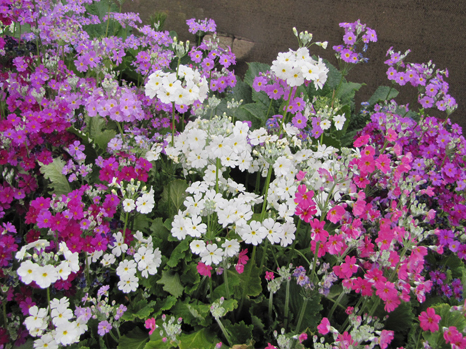 primula malacoides 'Mixed" Picture courtesy www.nuleaf.co.zaIn the Garden:
primula malacoides 'Mixed" Picture courtesy www.nuleaf.co.zaIn the Garden:
Primulas provide relief from a somewhat barren winter landscape, and no winter and spring garden is complete without their sea of dreamy colours, and an added bonus is that they are wonderful for attracting butterflies. They make a striking edging plant and put on a brilliant show if displayed in massed flowerbeds. If used as a background for spring flowering bulbs like daffodils, tulips, hyacinths, Dutch iris and cyclamens, fairy primroses will ensure a riotous display in spring.
Scatter some fairy magic throughout your garden by tucking fairy primroses into any small spots in the garden which receive semi-shade. You can even create your own meadow garden by planting them between ornamental grass-like plants, and if space is limited, include them in mixed plantings in window boxes, hanging baskets and pots, where the primulas will add vertical accent to the arrangement.
Cultivation/Propagation:
Primulas require cool conditions and high humidity to produce high quality plants and a general rule of thumb in successfully growing the vast majority of plants is to give them conditions that approximate those they would experience growing in the wild. This is especially true of fairy primroses which are native to woodlands and cool mountain conditions. Their broad, fleshy leaves have many stomata, and will rapidly wilt if subjected to harsh afternoon sunlight. For this reason, in hotter climates like South Africa we grow them as winter and spring flowering annuals for semi-shade.
Fairy primulas grow well almost throughout the country and are hardy to frost and low temperatures, but do not like heat together with high humidity. They do very well in the winter rainfall regions, and in the summer rainfall regions they must be watered regularly. Trays of seedlings are available from April, and in South Africa it is best to plant these no later than mid-May. If you know what colours you like, try to buy named varieties which are not yet in bloom, as planting fairy primulas ‘green’ is best.
Select planting sites which are protected from strong winds, and try to mimic their growing conditions in the wild by planting them in well-prepared beds where the soil drains well, and is rich in organic matter like compost.
If you wish to sow seeds, they can be sown into seedling trays or very well-prepared garden beds in late summer to early autumn, germinating best in soil temperatures between 18 and 22°C. You can sprinkle fine soil very lightly over the seeds, but do not plant too deep. Seeds can also just be raked, or pressed lightly into the soil. Keep the trays in a cool, shady spot until germination, which can take anything from 4 to 21 days, depending on temperatures. Your plants should start flowering within 14 to 18 weeks after sowing.
Keep the soil moist, but not sodden, and if you are growing in pots or baskets, pay particular attention to watering as fairy primroses do not like to get thirsty! Water your beds and pots early in the day to allow the leaves to dry out totally before nightfall, as this helps prevent fungal diseases.
This plant has moderate feeding requirements and should never be over fertilised. Adding a slow-release fertiliser to the potting soil or beds before planting should suffice. Alternatively, feed plants growing in garden beds with a water soluble fertiliser for flowering plants about every 6 weeks, and potted plants every 4 weeks.
Fairy primroses are easy to keep happy, and are sturdy plants which once they are established, requiring no attention beyond watering and the occasional dead heading.
Fairy primroses, especially the lavender shades, will self-seed in the garden and you will find them popping up all over the place from late summer, and these can be transplanted once big enough. If you allow your fairy primroses to seed themselves, you may never have to buy them again.
 Problems, Pests & Diseases:
Problems, Pests & Diseases:
Many primula disease problems can be avoided by good cultural habits, and planting and caring for them correctly will go a long way in avoiding primula plant problems.
The most important cultural requirement is excellent drainage, since the primula roots can be damaged in winter when soil is wet or heavy. If your plants do get root rot, damping off, or crown rot, they will wilt and die. Sadly there is no remedy, and you will need to throw out infected plants, and apply a fungicide to healthy plants to try to protect them.
Disfigured and discoloured leaves and flowers indicate a viral infection. Remove affected plants and control insects that may spread the disease.
The most important fungal disease of primula is botrytis, and the cool conditions and high humidity that primulas require to produce high quality plants, also favour the development of botrytis. Botrytis blight is caused by a fungus that attacks tender parts of the plant, and symptoms on flowers include spotting, discoloration, and wilting, and buds often fail to open. It may also look as though the flowers are old and fading. Leaves and shoots show brown lesions and masses of grey spores. Severely affected leaves and shoots will die back and the leaves will drop from the plant.
To help control and prevent this disease, practice good sanitation, water early in the day, and ensure that your plants are spaced correctly to allow for good air movement around the leaves. Also, although primroses don’t like to be thirsty, in cold winter conditions they will not require as much water. If the fungus appears, spray with a fungicide.
A powdery white coat on the plants indicates an infection with powdery mildew, and white tufts or a white covering on the lower surface of the leaves indicates an infection with downy mildew. Remove and dispose of all badly infected plants and start a regular spraying programme for the remaining healthy plants, using a suitable fungicide. To prevent infection improve ventilation, keep the roots moist but not soggy, water early in the day, and do not water the plants from above.
Primulas are susceptible to red spider mite, and any signs of fine spider webs on the plants indicate an infestation with red spider mites. These sap-sucking insects mainly appear on plants grown under glass, but can also attack garden plants. Red spider mites can be controlled with an appropriate insecticide, so contact your local garden centre for advice on how to eradicate them.
Honeydew, galls, and distorted leaves are a sign of aphid infestation which can easily be controlled with organic sprays.
Snails and slugs can be removed by hand or traps and pellets can be used.
Warning:
A few people are allergic to a chemical called "Primulin" which is found in all primula species, but especially in Primula malacoides and Primula obconica. Simply touching the hairs on the leaves of these two species may cause dermatitis or an itchy sensation not unlike poison ivy, but can also cause a severe rash, headaches or nausea. This has been somewhat bred out of newer hybrids, and relatively few people have a severe reaction. To be safe it is advised to wear gloves when handling this plant.
Always supervise babies and small children in the garden.
Primula vulgaris, also called the English or common primrose, is listed as toxic to cats, dogs and horses. This plant contains an unknown toxin which causes mild gastrointestinal upset including vomiting and diarrhoea in domesticated pets. If you suspect that your pet has eaten the plant, take them to the vet but do not panic, as the consequences appear less than mortal.
While dogs are not as susceptible to primrose poisoning as cats, they may still develop symptoms of toxicity. There have been no reported cases of death in a dog from primrose poisoning. However, it always remains a possibility.
Poppy, Icelandic Poppy, Arctic Poppy - Papaver nudicaule
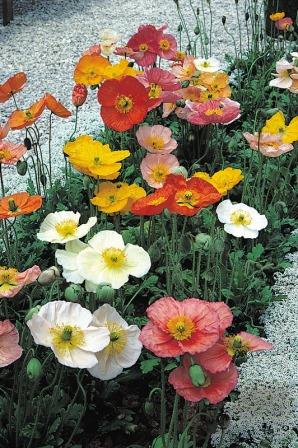 Poppy 'Champagne Bubbles Mix. Improved'Condensed Version
Poppy 'Champagne Bubbles Mix. Improved'Condensed Version
Poppies are available in bright and pastel shades of red, pink, yellow, orange, cream and white, as well as bicoloured varieties. There are several varieties like ‘Champagne Bubbles’ which are available in mixed and single colours. Poppies are also sought after cut flowers and the more you pick them, the more they bloom!
May is the perfect time to plant Iceland Poppy seedlings in South Africa. They love full sun and well-prepared beds with light well-drained soil to which compost and well-matured kraal manure has been added. They are hardy to frost and grow well throughout South Africa, except those very dry regions. Water regularly, as poppies don’t like to dry out completely, but be careful not to overwater them either, especially in the winter rainfall regions. Feed with 3:1:5 when the first buds appear.
Iceland poppies will flower all winter and spring if you nip out very first flowers and continually deadhead thereafter; removing the spent flowers by cutting them off at the base of the plant.
The different varieties of Iceland Poppies vary slightly in height from 30 to 45cm. Space them about 15cm apart in the garden. If you are purchasing trays of seedlings from your garden centre, choose small plants, as these transplant best. Seeds are best sown directly into well-prepared garden beds because poppies do not like undue disturbance. Be extremely gentle when transplanting as poppies have a weak tap-root that is easily damaged.
Full Version
Description, History & Interesting Facts About Iceland Poppies
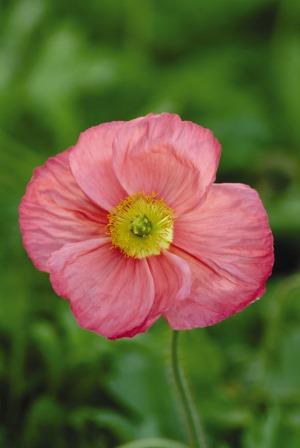 Poppy' Champagne Bubbles Pink' Picture courtesy www.ballstraathof.co.zaPoppies originated in the wilds of Northern Europe, Asia, and North America and have a long history in human civilization. In Mesopotamia they were already grown as ornamental garden plants since 5 000 B.C.E. and were also found in Egyptian tombs. In Greek mythology the poppy was associated with Dementer, goddess of fertility and agriculture. People also believed that they would have a bountiful harvest if poppies grew in their corn fields, hence the name “corn poppy”.
Poppy' Champagne Bubbles Pink' Picture courtesy www.ballstraathof.co.zaPoppies originated in the wilds of Northern Europe, Asia, and North America and have a long history in human civilization. In Mesopotamia they were already grown as ornamental garden plants since 5 000 B.C.E. and were also found in Egyptian tombs. In Greek mythology the poppy was associated with Dementer, goddess of fertility and agriculture. People also believed that they would have a bountiful harvest if poppies grew in their corn fields, hence the name “corn poppy”.
Iceland Poppies are old-time favourites that are easy to grow and will brighten up even the coldest winter day. From hairy tufts of linear blue-green foliage wiry stems arise, bearing a pendant bud. The single (occasionally double) short-lived flowers slowly un-wrinkle their petals into wide-spreading, elegant saucer shaped blooms, with crowns of golden stamens, and petals like fine crinoline.
These popular cut-flowers are available in bright and pastel shades of red, pink, yellow, orange, cream and white, as well as bicoloured varieties. There are several varieties like ‘Champagne Bubbles’ which is available in mixed and single colours.
How to use Iceland Poppies Effectively in the Garden
It is important to remember that seasonal colour is only used to embellish the framework of existing ornamental plants like perennials, shrubs, roses and ornamental trees, in a manner in which the various plants support each other visually and make a rich patchwork of texture and colour.
Iceland poppies attract butterflies to the garden and combine beautifully with most winter flowering annuals, making a fantastic backdrop for spring flowering bulbs. Try planting them in drifts, inter-planted with pansies or violas in complimentary or contrasting colours, for a brilliant display. They are wonderful in meadow and cottage gardens and also grow well in containers with other annuals.
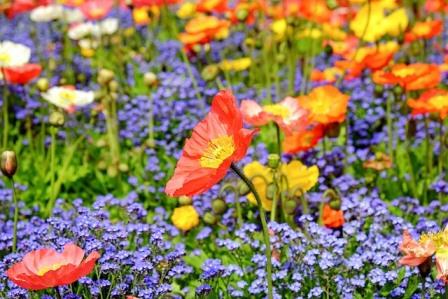 Image by Couleur from PixabayHow to make poppies last longer as cutflowers?
Image by Couleur from PixabayHow to make poppies last longer as cutflowers?
Poppies are sought after cutflowers and the more you pick them, the more they bloom! To make the flowers last in a vase, cut before the buds open, when you can just see some colour. Burn the ends of the stems over a candle flame, or plunge them into boiling water for a few seconds before arranging in cold water.
Tips on selecting companion plants for poppies
When deciding which flowering plants go together colour is obviously the first choice but it doesn’t end there, and it’s certainly an art to combine annuals effectively to create a colourful yet harmonious garden. Not only do you need to consider plants with contrasting and complementary colours, but also the growth requirements of your plant selection. Iceland poppies love full sun, good fertile soil which drains well, regular watering, and the occasional feeding. Therefore their companions should also enjoy the same growing conditions.
What colour combinations work best with Iceland poppies?
 Poppy' Champagne Bubbles Yellow' Picture courtesy www.ballstraathof.co.zaHow to use Analogous Colours in the landscape?
Poppy' Champagne Bubbles Yellow' Picture courtesy www.ballstraathof.co.zaHow to use Analogous Colours in the landscape?
Analogous colour involves working with two or three colours that are next to one another on the wheel, like orange, yellow and red. Your Iceland poppy selection will generally have predominantly yellow and orange flowers. Orange is a warm and vibrant colour and yellow is also warm, cheerful, and friendly, so they are naturally good companions for each other.
Creating a colourful border can be super easy when you plant different colours of the same species together, and Iceland poppies are perfect to implement this type of colour scheme using only two colours. One of the best ways to use the warm colours of Iceland poppies is to plant them in broad brushstrokes, and to repeat them in the garden, interspersed with their annual companions. This will create both drama and interest, and the recurring colour will draw the eye through the landscape and give it a cohesive feel.
In an analogous colour scheme usually one of the three colours predominates, but with Iceland poppies the orange and yellow will dominate equally. Adding small quantities of red flowers in the spaces between the drifts of poppies will just add that third element and make the colours ‘pop’ even more.
How to attract attention in the garden with warm colours?
Bold colours stand on their own, so shades of orange, yellow and red are perfect for drawing attention to your favourite landscape element, be it your front door, on the patio, or next to a brightly painted garden bench, these colours demand attention.
 Petunia Dreams 'White' Picture courtesy Ball StraathofHow to add contrast to the warm colours of Iceland poppies?
Petunia Dreams 'White' Picture courtesy Ball StraathofHow to add contrast to the warm colours of Iceland poppies?
If you use mainly warm colours in the spectrum from red through orange to yellow, you should add some cool colours to tone down the palette. Warm and cool colours always work well side by side, and warm colours like yellow, orange, and red tend to come forward or feel closer to you in the landscape, and cool colours like green, blue and purple, and variations of these colours, tend to go away from you, or feel distant to you and recede in a garden. If done well, contrast will add a whole new dimension and depth to the garden.
Both yellow and white are well matched in value, and although both vie for attention in the landscape, they will not detract from each other. And, although Iceland poppy selections usually include some white blooms, it would be good to add more white flowers to the mix.
How to use complimentary colours with yellow and orange Iceland poppies?
Complementary colours that are opposite each other on the colour wheel always works well together, and for both yellow and orange Iceland poppies blue is the best complementary colour as these two opposing hues are as different as night and day. Sadly there just aren’t many flowers that are true-blue in colour, so gardeners use colours that are adjacent to blue on the colour wheel like purple and violet to provide contrast for orange and yellow.
Thankfully, pansies and violas are perfect companions for Iceland poppies, and because they come in so many gorgeous shades of purple and violet, they are the obvious choice for adding contrast to your beds. Yellow, orange and white pansies and violas can also be planted between the poppies to bring the colour down to ground level for an even more striking display.
 Poppy 'Champagne Bubbles White' Picture courtesy www.ballstraathof.co.zaGreat Companions for Iceland Poppies
Poppy 'Champagne Bubbles White' Picture courtesy www.ballstraathof.co.zaGreat Companions for Iceland Poppies
Adding interest to your flower border can be as simple as mixing flowers with different shapes together, and Dianthus, Petunias, Lobelias, Alyssum, Pansies and Violas, will all serve this purpose and also provide wonderful colour contrast.
Alyssum
Alyssum is a compact, low-growing plant that is available in lovely in shades of pink, rose, purple, mauve, white and yellow.
Click here to read more about growing alyssum
Pansies & Violas
Pansies and violas are compact and come in an astounding range of colours, including yellow, orange and white, as well as the purples and violet shades that contrast so beautifully with Iceland poppies,
Click here to read more about growing pansies and violas.
Lobelias
Lobelias produce a profusion of tiny flowers in shades of blue, lilac, purple, pink, carmine and white, and some varieties have bright green leaves while others have bronzy foliage which contrasts well with Iceland poppies.
Click here to read more about growing lobelia
Petunias
Petunias also come in many shades of purple, lilac, blue and white, making them perfect to pair with Iceland poppies.
Click here to read more about growing petunias.
Dianthus
Dianthus remain firm favourites with gardeners and they are available in amazing shades, including mauve, purple and white, to enhance the colours of your poppies.
Click here to read more about growing dianthus
How to Cultivate Iceland Poppies?
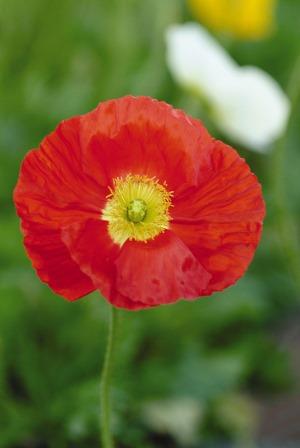 Poppy' Champagne Bubbles Scarlet' Picture courtesy www.ballstraathof.co.zaMay is the perfect time to plant Iceland Poppy seedlings in South Africa. They are hardy to frost and grow well throughout the country but may struggle in very dry regions.
Poppy' Champagne Bubbles Scarlet' Picture courtesy www.ballstraathof.co.zaMay is the perfect time to plant Iceland Poppy seedlings in South Africa. They are hardy to frost and grow well throughout the country but may struggle in very dry regions.
They love full sun and well-prepared beds with light well-drained soil to which compost and well-matured kraal manure has been added.
Water regularly, poppies don’t like to dry out completely, but be careful not to over water them either, especially in the winter rainfall regions. Feed with 3:1:5 when the first buds appear.
Iceland poppies will flower all winter and spring if you nip out very first flowers and continually deadhead thereafter; removing the spent flowers by cutting them off at the base of the plant.
The different varieties of Iceland Poppies vary slightly in height from 30 to 45cm. Space them about 15cm apart in the garden.
If you are purchasing trays of seedlings from your garden centre, choose small plants, as these transplant best.
Seeds are best sown directly into well-prepared garden beds because poppies do not like undue disturbance. Thin the seedlings out when they grow their first true leaves. If you do sow in seedling trays, transplant them into the garden as soon as they are strong enough. Be extremely gentle when transplanting as poppies have a weak tap-root that is easily damaged.
How to Propagate Iceland Poppies?
Allow a few plants to set seed and collect once the pods are fully ripe to store for next season.
Seeds will germinate best in soil temperatures between 18 and 22°C. Cover the seeds very lightly with soil and place your seedling trays in a cool, bright place until germination; which can take 7 to 14 days. Iceland poppies will take about 16 weeks to flower from seed.
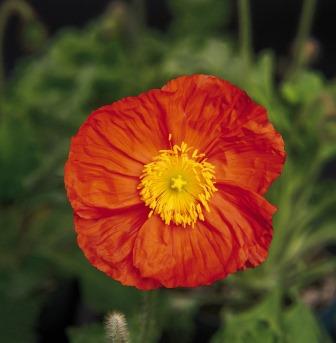 Poppy 'Champagne Bubbles 'Orange' Picture courtesy Ball StraathofWhich pests affect Poppies?
Poppy 'Champagne Bubbles 'Orange' Picture courtesy Ball StraathofWhich pests affect Poppies?
Slugs love Poppies, so monitor them closely for signs of slug damage and put down slug bait. Also, watch out for aphids and leaf-miners.
Warning:
The Iceland poppy is toxic to mammals, though the toxicity is low. The Canadian Biodiversity Information Facility noted that when horses, cattle and sheep ate discarded Iceland poppy plants, they were poisoned.
All poppies are poisonous, but not all contain opium. The alkaloids found in poppies differ with each species; some can affect the central nervous system (e.g., brain). Ingestion of any part of the plant can result in sedation or an excited (e.g., euphoric) state. Clinical signs of poppy or opioid poisoning include: inappetance (not eating), crying, pinpoint pupils (dogs), dilated pupils (cats), or staring off into space.
Alyssum, Honey Flower - Lobularia maritime
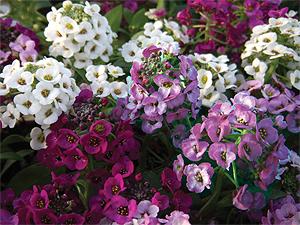 Clear Crystal Mixed Alyssum. Picture courtesy Ball Horticultural CompanyCondensed Version:
Clear Crystal Mixed Alyssum. Picture courtesy Ball Horticultural CompanyCondensed Version:
Alyssum is a compact, low-growing plant that remains one of the most popular summer bedding plants because it is low maintenance, long flowering and very easy to grow all year round. It is available in lovely in shades of pink, rose, purple, mauve, white and yellow. Plants will grow quickly to +-15cm tall and spread about 20 to 25cm.
It can be sown directly into well-prepared garden beds or seedling trays from spring to late summer and autumn thriving in full sun or light shade. It will grow in sandy soil and does well in coastal gardens. Plant it in fertile but very well drained soil and water regularly for best results. It is hardy to frost and will tolerate drought but grows best if watered regularly.
Full Version:
Description, History & Interesting Facts:
Alyssum is a compact, low-growing plant that remains one of the most popular summer bedding plants because it is low maintenance, long flowering and very easy to grow all year round. Its honey scented flower spikes will attract bees and butterflies to the garden and are available in lovely in shades of pink, rose, purple, mauve, white and yellow.
Alyssum is native to northern Africa i.e. northern Algeria, Egypt, northern Libya, Morocco and Tunisia, the Azores, the Madeira Islands, the Canary Islands and southern Europe i.e. France, Portugal, Spain, Italy, Albania and Greece. It has escaped cultivation and is now widely naturalized elsewhere in the temperate world.
The genus name Lobularia comes from the Greek word meaning "small pod", referring to the shape of the fruits. The name of the species maritima refers to its preferred coastal habitat.
 Clear Crystal White Alyssum. Picture courtesy Ball Horticultural CompanyIn the Garden:
Clear Crystal White Alyssum. Picture courtesy Ball Horticultural CompanyIn the Garden:
Alyssum is a low grower that makes a wonderful carpet-like ground cover, and, as the plants spread, they will create a living mulch under taller plants. You can also use it as an edging plant in the garden, or to fill nooks and crannies on walkways and walls. If you plant it near stone or anywhere that dries out quickly, you will need to provide some extra water.
The tight, free-flowering plants are also great in hanging baskets and containers, mixing effortlessly with other flowering plants in all manner of containers for months of colour. Plant it as a border to the fruit and vegetable garden, because Alyssum attracts vital insect pollinators like bees to the garden.
![]() Cultivation/Propagation:
Cultivation/Propagation:
Alyssum thrives in full sun or light shade. It will grow in sandy soil and does well in coastal gardens. Plant it in fertile but very well drained soil and water regularly for best results. It is hardy to frost and will tolerate drought but grows best if watered regularly. Plants will grow about 15cm tall and spread about 20 to 25cm. Alyssum will seed itself around the garden under favourable conditions.
Deadheading will keep the plants flowering for longer, and if you have a large drifts of plants, shearing them by 1/3 would be an easier option than deadheading, and they will set new buds quickly.
Seed can be sown directly into well-prepared garden beds or seedling trays from spring to late summer and autumn, when temperatures are between 20 and 26°C. Cover the seeds lightly with sifted soil or vermiculite. They germinate in about 3 days and take up to 9 weeks to flower.
![]() Pests & Diseases:
Pests & Diseases:
Sweet Alyssum is remarkably problem free. Aphids can become a pest, especially when the plants are under stress.
Warning:
Lobularia maritima is non toxic to humans, cats, dogs and horses.
Calendula, English Marigold, Pot Marigold - Calendula officinalis
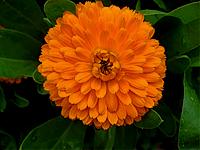 Condensed Version:
Condensed Version:
This fun and fast growing winter and spring flowering annual is easy to germinate and simple to care for, producing large, single or double flowers that last long in a vase. The clear, bright colours are orange to apricot-orange and golden to lemon-yellow. Both dwarf and tall strains are available, varying in height from 20 to 75cm tall, but the dwarf varieties are the most freely available in South Africa. Calendula is a satisfying choice for novice gardeners and children because it rewards quickly with generous crops of showy flowers.
Calendulas grow throughout South Africa in full sun or light shade and are hardy to all but severe frost. They will grow in almost all kinds of soils but for best results plant in fertile, well-drained soil. Continually pick for the vase and remove the spent flowers regularly, to encourage more blooms.
The seeds can be sown directly into garden beds in autumn when the soil has cooled down and the daytime temperatures are between 20 to 22°C. Cover them lightly with about 2cm of soil and water well until germination takes place. Calendula grows quickly and come into bud about 13 to 14 weeks after sowing, after which you can feed them with a fertiliser like 3:1:5. They will continue blooming for about 10 weeks in winter and spring.
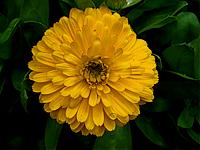 Full Version:
Full Version:
Description, History & Interesting Facts:
This fun and fast growing winter and spring flowering annual is easy to germinate and simple to care for, producing large, single or double flowers that last long in a vase. The clear, bright colours are orange to apricot-orange and golden to lemon-yellow. Both dwarf and tall strains are available, varying in height from 20 to 75cm tall, but the dwarf varieties are the most freely available in South Africa. Calendula is a satisfying choice for novice gardeners and children because it rewards quickly with generous crops of showy flowers.
The leaves and petals are edible; outer petals of the flowers are used in cooking as a garnish, flavouring and colouring agent in soups, stews, cheeses, and margarine. Leaves can be sweet but are more commonly bitter, and may be used in salads.
Calendula has been grown for centuries and is native to Southern Europe around the Mediterranean Sea, where it was greatly valued by the ancient Romans and Greeks and cultivated by monks in medieval times for its healing properties. It was also used by and early Indian and Arabic cultures as a medicinal herb, a dye for fabrics, in cosmetics, and to flavour foods.
Uses:
Calendula is still used medicinally today in creams and ointments to soothe skin and sprained muscles. It can be used topically to treat itchy skin on dogs and cats, and freshly chopped calendula plants (without the roots) can be added to chicken feed to make the meat tender, with a yellowish colour. It also gives the yolks a bright yellow colour, adding to their flavour.
Find out more about using Calendula as a herb here
In the Garden:
Calendula perform best when sown directly into garden beds, and the seed is very inexpensive, making it a most economical winter crop to sow. And, because the mature seed is quite large, it can easily be collected and saved for next season. An added bonus is that calendula will grow happily in full sun or light shade, making it super versatile in the garden, and especially good for those garden beds where the sun pattern changes from full sun to semi-shade during the day.
Sown in massed beds or as an edging plant alongside walkways, calendulas can put on quite a show. They also complement other seedings if planted out from nursery trays into window boxes, hanging baskets etc. providing many weeks of warm winter colour.
Calendula is a renowned "companion plant" for other garden plants, helping to keep those growing nearby healthy. Sow them between your winter vegetable crops for a healthier and very pretty winter veggie patch.
![]() Cultivation/Propagation:
Cultivation/Propagation:
Calendulas grow throughout South Africa in full sun or light shade and are hardy to all but severe frost. They will grow in almost all kinds of soils but for best results plant in fertile, well-drained soil. Continually pick for the vase and remove the spent flowers regularly, to encourage more blooms.
The seeds can be sown directly into garden beds in autumn when the soil has cooled down and the daytime temperatures are between 20 to 22°C. Cover them lightly with about 2cm of soil and water well until germination takes place. Calendula grows quickly and come into bud about 13 to 14 weeks after sowing, after which you can feed them with a fertiliser like 3:1:5. They will continue blooming for about 10 weeks in winter and spring.
Allow a few plants to set seed at the end of the season to collect and store in a paper bag.
![]() Problems, Pests & Diseases:
Problems, Pests & Diseases:
Calendula is bothered by few pests or cultural problems providing the soil is well-drained. In less than perfectly draining soils they are susceptible to root rots and you may have to discard the plants. If rust becomes a problem it can be controlled with an organic fungicide.
Watch out for snails and slugs, as well as aphids which suck the plant sap, but can easily be washed off with a strong jet of water, or by spraying with an insecticidal soap. Spider Mites also suck on the plant juices causing white dots on the foliage. There is also often webbing visible on the plant. They thrive in dry conditions and cause the foliage to turn yellow and become dry and stippled. Spider Mites multiply quickly and will require regular spraying with an insecticidal soap or other appropriate organic spray to break their breeding cycle.
Warning:
Calendula is non-toxic to humans and animals but allergic reactions are common to plants of the Aster family, of which calendula is a member. There is thus a slight risk of mild irritation when calendula is applied topically. It is estimated that perhaps only one percent of people may experience such a reaction, and perhaps even fewer animals. If redness or itch occurs in response to calendula, discontinue its use.
Ornamental Kale/Cabbage - Brassica oleracea
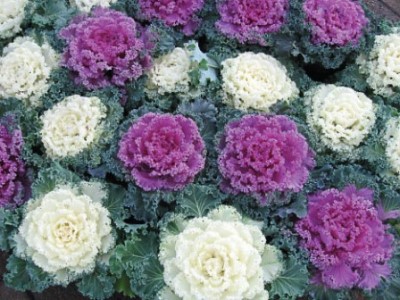 Ornamental Kale Picuture courtesy www.nuleaf.co.zaCondensed Version:
Ornamental Kale Picuture courtesy www.nuleaf.co.zaCondensed Version:
Ornamental cabbages produce giant rosettes of frilly leaves in wonderful shades of lavender, rose; white, and creamy yellow, making them a favourite addition to cold winter gardens. The pigmentations for which these plants are known do not appear until after prolonged cool weather and several frosts. They are ideal for displaying on porches, patios, beside entryways, or for massing in garden beds. Be adventurous and try combining them with other seedlings in pots and window boxes.
Ornamental cabbages are grown as winter annuals in South Africa and seeds can be sown in autumn, or you can purchase trays of seedlings, or potted plants from your garden centre. They are easy to grow and hardy. They love a sunny location, but will take some shade. These plants prefer a moderately moist, rich soil; and because they can’t stand overly dry conditions, keep them well-watered, never allowing the soil to dry out completely. Too much fertiliser can interfere with colour and cause stem elongation, so fertilising at planting time should be sufficient. The plants will grow about 20cm tall and 30cm wide, depending on the variety. Cut off the flower stems as soon as they appear.
Seeds are easily sown directly into garden beds or seedling trays in autumn. The seeds require light for germination, so do not cover them with soil. Sow about six to ten weeks before the first anticipated frost so that your plants can acclimatise gradually to the cold. Ornamental cabbages are very hardy but a sudden cold- snap can be deadly to tiny plants. The seeds should germinate within 10 to 14 days and be in full-colour within 6 to 8 weeks after sowing. Seedling trays or potted plants can be planted out anytime, but if you are planting out seedlings or pots a bit late in the season, they must be gradually acclimatized to severe outdoor temperatures, or a sudden very cold snap could be deadly, especially for small plants. If you have planted out and suspect extreme weather, cover them with frost guard material until they are acclimatised. When purchasing ornamental cabbages in pots, select plants with short stems. Generally, if these plants were allowed to become root bound in their pots, they will not get much larger after they are planted out, so it may pay in the long run to buy the biggest plants you can find, even though they may cost more. Plant potted plants so the lowest leaves are flush with the ground.
Full Version:
Description, History & Interesting Facts:
Ornamental cabbages look much the same as their edible cousins, but produce giant rosettes of frilly leaves in wonderful shades of lavender, rose; white, and creamy yellow, making them a favourite addition to cold winter gardens. The pigmentations for which these plants are known do not appear until after prolonged cool weather and several frosts. Ornamental cabbages can also be grown as seasonal indoor pot plants but require a brightly lit, yet cool room.
The original wild cabbage, from which kale, collards, cabbage, broccoli and cauliflower crops were developed, still grows along the coasts of North Africa and Europe. Botanists, through hybridizing by cross-pollination, developed ornamental cabbages and kales and although they are still edible, are not as tasty and tender as their cousins.
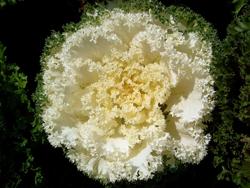 Ornamenta kale 'White'Uses:
Ornamenta kale 'White'Uses:
They all make unusual additions to fresh flower arrangements, and the taller growing varieties are especially sought after by florists for their long stems.
In the Garden:
Because these showy cabbages can hold their brilliant colour all the way into spring, they are ideal for displaying on porches, patios, beside entryways, or for massing in garden beds. When massed in large beds they make a striking contrast to modern architecture. Be adventurous and try combining them with other seedlings in pots and window boxes.
Cultivation:
Ornamental cabbages are grown as winter annuals in South Africa and seeds can be sown in autumn, or you can purchase trays of seedlings, or potted plants from your garden centre. They are easy-to-grow and hardy, even when the ground is frozen solid and the temperatures are way below freezing. Ornamental Cabbages should be planted in a sunny location, but they will take some shade. They prefer a moderately moist, rich soil; and because they can’t stand overly dry conditions, keep them well-watered, never allowing the soil to dry out completely, but be careful not to drown them either! Too much fertiliser can interfere with colour and cause stem elongation, so fertilising at planting time with a balanced granular fertiliser like 3:2:1 or 2:3:2 should be sufficient. The plants will grow about 20cm tall and 30cm wide, depending on the variety. Cut off the flower stems as soon as they appear.
Seeds are easily sown directly into garden beds or seedling trays in autumn, germinating best in soil temperatures between 18 and 21°C. The seeds require light for germination, so do not cover them with soil. Sow the seeds about six to ten weeks before the first anticipated frost so that your plants can acclimatise gradually to the cold. Ornamental cabbages are very hardy but a sudden cold- snap can be deadly to tiny plants. The seeds should germinate within 10 to 14 days and be in full-colour within 6 to 8 weeks after sowing.
 Ornamental kale 'Purple'Seedling trays or potted plants can be planted out anytime, but if you are planting out a bit late in the season, they must be gradually acclimatized to severe outdoor temperatures, or a sudden very cold snap could be deadly, especially for small plants. If you have planted out and suspect extreme weather, cover them with frost guard material until they are acclimatised.
Ornamental kale 'Purple'Seedling trays or potted plants can be planted out anytime, but if you are planting out a bit late in the season, they must be gradually acclimatized to severe outdoor temperatures, or a sudden very cold snap could be deadly, especially for small plants. If you have planted out and suspect extreme weather, cover them with frost guard material until they are acclimatised.
When purchasing ornamental cabbages in pots, select plants with short stems. Generally, if these plants were allowed to become root bound in their pots, they will not get much larger after they are planted out, so it may pay in the long run to buy the biggest plants you can find, even though they may cost more. Plant the potted plants so the lowest leaves are flush with the ground.
Pests & Diseases:
Watch out for cabbage worms, harlequin bugs, slugs, grasshoppers, and cabbage aphids
Pansy - Viola x wittrockiana hybrids
 Pansy F1 'Frizzle Sizzle' Picture courtesy Ball StraathofCondensed Version:
Pansy F1 'Frizzle Sizzle' Picture courtesy Ball StraathofCondensed Version:
Pansies and violas are timeless winter and spring flowering favourites and come in a staggering range of bright or pastel colours: including pink, blue, yellow, gold, orange, purple, violet, red, russet, white, and even black. They are available in clear single shades as well as bi-colours. The flowers range in size from small to enormous, with petals that are soft and velvety, and often ruffled and frilly. Viola flowers are much smaller than those of pansies, but the smaller types of both violas and pansies are the most popular with gardeners because they produce many more flowers at a time than the large and extra-large pansies.
They vary slightly in height from about 15 to 20cm, and are grown as annuals throughout South Africa, and planted out in autumn and winter to flower in winter and spring. During the winter months they love to grow in full sun, but if you live in a cool region and wish to plant them in spring and summer, they will need semi-shade.
Pansies and violas do not like heat and humidity, and in hot regions they are planted out during the coolest months. In cool, mist-belt regions they can be kept blooming for months and months if they are planted in areas of the garden which receive full winter sun, but are semi-shaded in summer, i.e. under deciduous trees.
Some varieties of viola like "Johnny Jump-up" are easy to sow from seed, but pansies are generally finicky from seed, and it’s a lot easier to buy established plants from a local garden centre. Plus, you’ll get blooms a lot sooner.
They are hardy to frost, surviving freezing weather, even when in full bloom. In extremely cold regions place a thick mulch of straw or bark chips around their roots to protect the soil from freezing. Pansies and violas must not be planted in the same soil season after season as harmful organisms can build up in the soil and eventually kill the plants, so practice plant rotation.
They enjoy fertile, humus rich soils, but to avoid root-rot it is vital that the soil has excellent drainage. Dig the beds over well adding compost and a dressing of bone meal. Never transplant your seedlings deeper than they are growing in their trays, and ensure that no soil is covering the crown, or the plants will wilt and die. It is also important to space the plants correctly, so check the information on the plant labels. Remember to water regularly, however, it is vital that you do not overwater, and it is best to water well every couple of days, rather than giving a sprinkling of water every day.
Potted pansies and violas can be grown in a good potting soil which drains well, and in pots they can be planted slightly closer together for effect. Potted plants need more frequent watering than those growing in garden beds, so check your pots regularly. It is easiest to feed potted plants with liquid fertilisers, so invest in one for flowering plants.
To keep your pansies and violas blooming for a long time it is important to nip out all the dead flowers on a regular basis. Otherwise they need little further attention, beyond a feeding every 4 to 6 weeks with a fertiliser for flowers.
 Pansy 'Mammoth Mix' Picture courtesy Ball StraathofFull Version:
Pansy 'Mammoth Mix' Picture courtesy Ball StraathofFull Version:
Description, History & Interesting Facts:
Pansies and violas are timeless winter and spring flowering favourites that never go out of fashion. One of their common names is "little faces" because their pretty heart-shaped flower petals often have delicate patterns that resemble little pansy 'faces'. Pansies and violas come in a staggering range of bright or pastel colours: including pink, blue, yellow, gold, orange, purple, violet, red, russet, white, and even black. They are available in clear single shades as well as bi-colours, and many are painted with black blotches around a yellow eye, with lines radiating from the centre, like cat's whiskers.
Pansies and violas vary slightly in height from about 15 to 20cm, and their small stature makes them perfect for borders and containers. The flowers range in size from small to enormous, with petals that are soft and velvety, and often ruffled and frilly. Viola flowers are much smaller than those of pansies, and the modern F1 hybrid pansies come in several sizes, from the smaller 5 to 6cm ones which flower most prolifically, to the medium, large, and extra-large pansies which can produce flowers the size of a small saucer! The small to medium sizes produce more flowers per plant than the very large flowering varieties, and for this reason the smaller types are the most popular with gardeners. If you simply can’t resist the extra-large flowers, buy some to impress your friends, plant them in containers and place them where they can serve as a focal point.
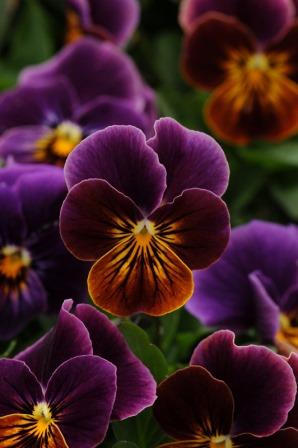 Viola Sorbet 'Antique Shades' Picture courtesy Ball StraathofAccording to legend all pansies were once white, and only when cupid shot an arrow into the white pansy, did the beautiful coloured varieties emerge. Even in ancient Greece violas were associated with love and fertility and used in love potions. In Victorian times pansies were also thought of in terms of love, and it was believed that if you sent your lover a bouquet of pansies, he or she would think of you. In William Shakespeare’s "A Midsummer Night’s Dream" pansies were used as a love potion, and played a significant role in creating a central theme throughout the play of love manipulation.
Viola Sorbet 'Antique Shades' Picture courtesy Ball StraathofAccording to legend all pansies were once white, and only when cupid shot an arrow into the white pansy, did the beautiful coloured varieties emerge. Even in ancient Greece violas were associated with love and fertility and used in love potions. In Victorian times pansies were also thought of in terms of love, and it was believed that if you sent your lover a bouquet of pansies, he or she would think of you. In William Shakespeare’s "A Midsummer Night’s Dream" pansies were used as a love potion, and played a significant role in creating a central theme throughout the play of love manipulation.
All the pansies we know and love today are hybrids that were developed from the wild viola species (Viola tricolour) and are named Viola x wittrockiana hybrids. The Viola family contains over 400 species, with many sub-species, which are widely distributed over the temperate zones of both the Northern and Southern hemispheres.
The name "pansy" is derived from the French "pensée" meaning 'thought' and was so named because the flower resembles a face nodding forward, as if deep in thought. Because of this, the pansy has also long been a symbol of free thought.
Pansies and violas continue to inspire plant breeders to produce even more exciting garden varieties, with exciting colours like the new antique mixes, as well as gorgeous new bicolour combinations. Breeding is also focused on producing even more compact and floriferous plants. Grab a couple of trays of pansies and violas from you garden centre and plant them in a few key locations in the garden, they are worth their weight in gold!
Uses:
Pansies and violas are one of several edible garden flowers, and their mild, minty flavour makes for a pretty edible garnish for salads or desserts.
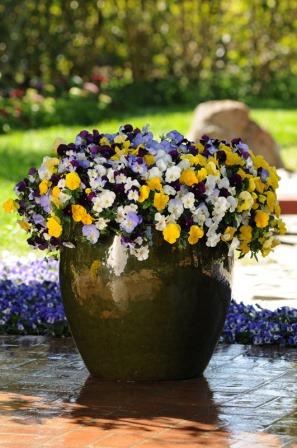 Pansy 'Cool Wave Mix' Picture courtesy Ball StraathofIn the Garden:
Pansy 'Cool Wave Mix' Picture courtesy Ball StraathofIn the Garden:
Pansies and violas are easy to grow and perfect for hanging baskets and containers of all kinds. They are charming when combined with spring flowering bulbs and also grow well with other winter and spring flowering annuals for full sun. Line the borders of the vegetable, flower or herb garden with them to attract bees and other valuable pollinators at a time when food is scarce.
Violas can take a bit more shade than pansies making them perfect for brightening up semi-shady areas. Violas will also often re-seed themselves in the garden.
Cultivation/Propagation:
Pansies and violas love full sun, and are grown as annuals throughout South Africa. Generally they are sown or planted out in autumn and winter to flower in winter and spring. In the cool, mist-belt regions they can be kept blooming for months and months if they are planted in areas of the garden which receive full winter sun, but are semi-shaded in summer, i.e. under deciduous trees. In these regions they can also be sown in spring, but then they will need semi-shade.
Pansies and violas do not like heat and humidity, and in hot regions of the country they are planted out during the coolest months. They are hardy to frost, surviving freezing weather, even when in full bloom. In extremely cold regions place a thick mulch of straw or bark chips around their roots to protect the soil from freezing. In the winter rainfall regions the soil must have perfect drainage.
Some varieties of viola like "Johnny Jump-up" are easy to sow from seed, but pansies are generally finicky from seed, and it’s a lot easier to buy established plants from a local garden centre. Plus, you’ll get blooms a lot sooner.
Pansies and violas must not be planted in the same soil season after season as harmful organisms can build up in the soil and eventually kill the plants, so practice plant rotation, just like you would in the vegetable garden.
They enjoy fertile, humus rich soils, but to avoid root-rot it is vital that the soil has excellent drainage. Dig the beds over well adding compost and a dressing of bone meal. Never transplant your seedlings deeper than they are growing in their trays, and ensure that no soil is covering the crown, or 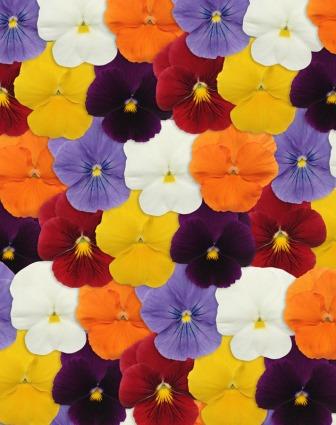 Pansy Panola 'Clear Mix' Picture courtesy Ball Straathofthe plants will wilt and die. It is also important to space the plants correctly, and spacing will vary, so check the information on the plant labels.
Pansy Panola 'Clear Mix' Picture courtesy Ball Straathofthe plants will wilt and die. It is also important to space the plants correctly, and spacing will vary, so check the information on the plant labels.
Remember to water regularly, as one of the most common reasons pansies and violas fail is because they are not watered enough, so if your pansies are not doing well, try watering them more. However, it is vital that you do not overwater, and it is best to water well every couple of days, rather than giving a sprinkling of water every day.
Potted pansies and violas can be grown in a good potting soil which drains well, and in pots they can be planted slightly closer together for effect. Potted plants need more frequent feeding and watering than those growing in garden beds, so check your pots regularly. It is easiest to feed potted plants with liquid fertilisers, so invest in one for flowering plants.
To keep your pansies and violas blooming for a long time it is important to nip out all the dead flowers on a regular basis. Otherwise they need little further attention, beyond a feeding every 4 to 6 weeks with a fertiliser for flowers.
As the season wears on you’ll probably notice the plants getting leggy. Go ahead and cut them back by as much as one-third, but be sure to leave some foliage to nourish the plant. However, if it’s late in the season and the plants aren’t looking too vigorous, you’re better off just pulling them out and replacing them with summer flowers.
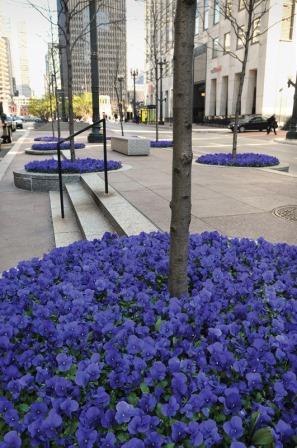 Pansy 'Panola True Blue Mix' Picture courtesy Ball StraathofSeeds are best sown in seedling trays in late summer to early autumn. In cool, temperate regions they are also sown in spring. The ideal soil germination temperatures are between 18 and 24°C and the seeds can take up to a week to germinate.
Pansy 'Panola True Blue Mix' Picture courtesy Ball StraathofSeeds are best sown in seedling trays in late summer to early autumn. In cool, temperate regions they are also sown in spring. The ideal soil germination temperatures are between 18 and 24°C and the seeds can take up to a week to germinate.
Problems, Pests & Diseases:
Because pansies and violas are winter annuals they do not suffer from many pests, but as the weather warms up in spring and early summer, suddenly the pests can arrive from seemingly nowhere, so keep an eye out for common garden pests like slugs, snails, and aphids.
Most diseases like crown and root rot can be avoided by planting in well-drained soil, ensuring spacing is correct, and by watering correctly. Pansies and violas do not like heat or humidity and under these conditions are susceptible to downy mildew, powdery mildew, rust and grey mould.
Warning:
Pansies and violas are not poisonous and the flowers are used to garnish salads. However, it is always good to supervise small children in the garden and to discourage pets from chewing on plants.
Petunia - Petunia x hybrida
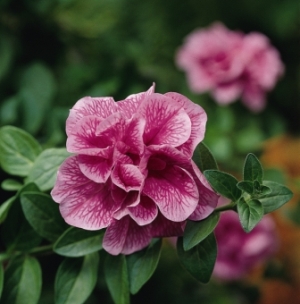 Double Pink Lilac Petunia. Picture courtesy Ball Horticultural CompanyPetunias are popular low-growing annuals that originate in South America. Thousands of hybrids have been bred throughout the years and the flower sizes and shapes vary greatly. Some varieties have darker veins in the flowers, stripes or frilly edges. Others have small single flowers in profusion and then you get the huge frilly, double varieties. They are available in an outstanding array of colours varying from fiery reds, burgundy and purples, to all shades of pink, lilac, blue, yellow and white. Petunias bloom continuously all season with little maintenance and make perfect centrepieces to mixed plantings in pots, hanging baskets and window boxes. They are excellent border plants and if planted in mass, will provide brilliant colour for months on end. Use the cascading varieties in containers and the compact varieties in the garden.
Double Pink Lilac Petunia. Picture courtesy Ball Horticultural CompanyPetunias are popular low-growing annuals that originate in South America. Thousands of hybrids have been bred throughout the years and the flower sizes and shapes vary greatly. Some varieties have darker veins in the flowers, stripes or frilly edges. Others have small single flowers in profusion and then you get the huge frilly, double varieties. They are available in an outstanding array of colours varying from fiery reds, burgundy and purples, to all shades of pink, lilac, blue, yellow and white. Petunias bloom continuously all season with little maintenance and make perfect centrepieces to mixed plantings in pots, hanging baskets and window boxes. They are excellent border plants and if planted in mass, will provide brilliant colour for months on end. Use the cascading varieties in containers and the compact varieties in the garden.
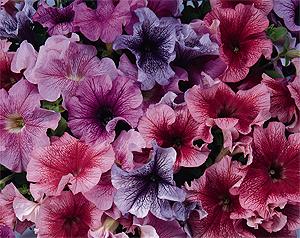 Daddy Mix Petunia. Picture courtesy Ball Horticultural CompanyPetunias can be planted almost all year round in South Africa and are semi-hardy to moderate frost. They love full sun (at least 6 hours a day). The different varieties vary in height and spread so check carefully before making your selection. Plant them in very well-drained, composted soil. Excessive rains will ruin the flowers and can even cause the plants to rot, so be judicious with water and make sure the soil is well-drained. Too much water will cause the plants to become "leggy", with lots of stem and few flowers. To keep them blooming for longer feed them monthly with a granular fertiliser or a foliar spray for flowering plants. Petunias must not be planted in the same soil season after season as harmful organisms can build up in the soil and
Daddy Mix Petunia. Picture courtesy Ball Horticultural CompanyPetunias can be planted almost all year round in South Africa and are semi-hardy to moderate frost. They love full sun (at least 6 hours a day). The different varieties vary in height and spread so check carefully before making your selection. Plant them in very well-drained, composted soil. Excessive rains will ruin the flowers and can even cause the plants to rot, so be judicious with water and make sure the soil is well-drained. Too much water will cause the plants to become "leggy", with lots of stem and few flowers. To keep them blooming for longer feed them monthly with a granular fertiliser or a foliar spray for flowering plants. Petunias must not be planted in the same soil season after season as harmful organisms can build up in the soil and 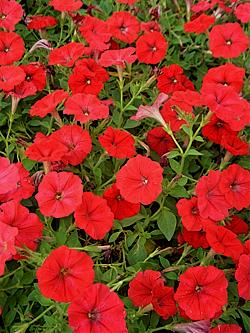 Petunia Easy Wave Redeventually kill the plants.
Petunia Easy Wave Redeventually kill the plants.
Older varieties of petunias require diligent deadheading or they will stop blooming. Even the newer varieties that say they don't require deadheading will benefit from a pinching or shearing mid-season. When the branches start to get too long and you can see where all the previous flowers were along the stem, it's time to cut them back and refresh the plant.
Seeds are best sown in seedling trays and can be sown almost all year round as long as temperatures are not below 25°C. The seeds need light to germinate, so don't cover the seed with soil but rather sprinkle the tiny seeds onto the surface of the soil and gently press them in. Petunia seed can start germinating after a few days or can take up to a week or more, depending on conditions. Place the trays in a warm place with bright light.
The two oldest types of petunias are grandifloras and multifloras and both grow in a mound-like shape. Grandiflora varieties have larger flowers, but multiflora varieties hold up better in the rain.
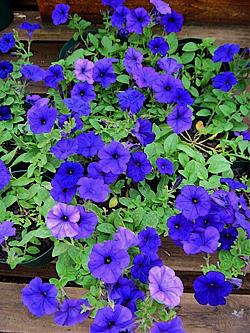 Petunia Easy Wave BlueCertain varieties like the 'Wave' 'Supertunia' 'Cascadia' and 'Surfinia' series' of petunias are most popular because they make an excellent groundcover for large areas and can be used as bedding plants or trailing in containers. These are actually short-lived perennial plants that can last up to two years before being replaced. They will grow about 20cm talland90cm wide, depending on how closely they are planted together.
Petunia Easy Wave BlueCertain varieties like the 'Wave' 'Supertunia' 'Cascadia' and 'Surfinia' series' of petunias are most popular because they make an excellent groundcover for large areas and can be used as bedding plants or trailing in containers. These are actually short-lived perennial plants that can last up to two years before being replaced. They will grow about 20cm talland90cm wide, depending on how closely they are planted together.
Tidal Wave petunias (Hedgiflora) grow outward and upward, forming a dense, mounded hedge. Their height will depend on how closely they are planted together. If spaced about 30cm apart they will grow 40 to 55cm tall and if spaced 60cm apart, 20 to 30cm tall. These versatile plants can even be trained to grow as a creeper if they are supported by a trellis.
Single petunias like the Carpet Series are very compact growing and excellent for garden beds and borders.
Double petunias are grandiflora hybrids that produce fewer but large double blooms. They are beautiful in hanging baskets, mixed with other annuals like alyssum.
New Guinea Impatiens - Impatiens hawkeri
Marigold - Tagetes erecta
 The marigolds we grow in our gardens were actually bred from plants native to North and South America but the first garden plants introduced into Europe came from Northern Africa; hence the confusing names. There are two basic types of marigold; the large-flowered marigold (Tagetes erecta), that is called the African or American marigold and the smaller-flowered French marigold (Tagetes patula). The French marigold is native to Mexico, Nicaragua and Guatemala. The so called "African" marigold is native to the American tropics, where about 50 species occur.
The marigolds we grow in our gardens were actually bred from plants native to North and South America but the first garden plants introduced into Europe came from Northern Africa; hence the confusing names. There are two basic types of marigold; the large-flowered marigold (Tagetes erecta), that is called the African or American marigold and the smaller-flowered French marigold (Tagetes patula). The French marigold is native to Mexico, Nicaragua and Guatemala. The so called "African" marigold is native to the American tropics, where about 50 species occur.
Marigolds are available in all shapes and sizes, from dwarf to tall growing; single or double varieties, all with intense flower shades and mixtures of, orange, yellow, gold, maroon, and mahogany, flame red and light creamy-yellow. Marigolds are good cut-flowers and can be dried. These tough annuals are perfect "learner plants" for demonstrating plant care and the miracle of seed germination to young children.
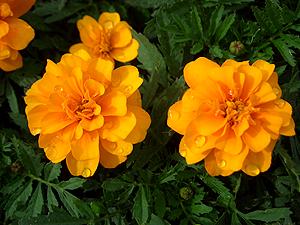 The marigold is a workhorse of the garden, blooming virtually non-stop for the entire summer. There are dwarf, medium and tall varieties available that vary in height from 20cm to 90cm tall. The dwarf varieties make excellent edging plants and combine beautifully with other annuals in containers. The taller varieties look beautiful mixed with other summer annuals in flowerbeds or in massed plantings of a single variety.
The marigold is a workhorse of the garden, blooming virtually non-stop for the entire summer. There are dwarf, medium and tall varieties available that vary in height from 20cm to 90cm tall. The dwarf varieties make excellent edging plants and combine beautifully with other annuals in containers. The taller varieties look beautiful mixed with other summer annuals in flowerbeds or in massed plantings of a single variety.
Marigolds are easy-to-grow throughout South Africa. They thrive in hot climates and will adapt to most garden soils, but prefer lightly composted, well-drained soil and full sun. Very rich soil will result in lots of leaves and fewer flowers. Water them regularly but do not overwater. Cut out the dead flowers often to prolong flowering.
Seeds can be sown directly into garden beds in or seedling trays in spring and summer and germinate best in soil temperatures between 22 and 26°C. Cover the seeds lightly with soil or vermiculite. They will germinate within 4 to 7 days and bloom about 10 to 12 weeks after sowing.
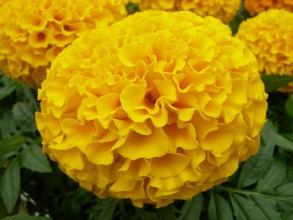 Marigold 'Taishan' Picture courtesy www.ballstraathof.co.za(Marigold 'Taishan') is a dwarf bedding marigold with large double flowers that was featured in the landscapes specially constructed for the 2008 Olympic Games in Beijing, China. The marigolds thrived throughout the high humidity and extraordinary heat of the summer. The tightly petalled blooms are carried on super-strong stems and hold their shape for longer delivering high impact colour. They also tolerate overhead watering. The plant was named after the Taishan Mountains, regarded as preeminent among China's five sacred mountains and means "stability". It is available in gold, yellow orange and a mix of colours.
Marigold 'Taishan' Picture courtesy www.ballstraathof.co.za(Marigold 'Taishan') is a dwarf bedding marigold with large double flowers that was featured in the landscapes specially constructed for the 2008 Olympic Games in Beijing, China. The marigolds thrived throughout the high humidity and extraordinary heat of the summer. The tightly petalled blooms are carried on super-strong stems and hold their shape for longer delivering high impact colour. They also tolerate overhead watering. The plant was named after the Taishan Mountains, regarded as preeminent among China's five sacred mountains and means "stability". It is available in gold, yellow orange and a mix of colours.


